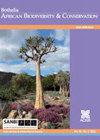受入侵病原体威胁的开普花区极危变形科植物
IF 0.5
4区 生物学
Q4 PLANT SCIENCES
引用次数: 2
摘要
背景:sorcephalus imbricatus(拇指)R.Br。是南非开普区特有的一种范围限制物种。根据世界自然保护联盟的标准,它目前被列为极度濒危物种。与许多其他CFR特有物种一样,毛茛也面临栖息地丧失、栖息地退化和外来入侵物种的影响等主要威胁。最近发现,在迁地收集中需要改进代表性的物种是Sorocephalus imbricatus。在为此目的收集种质的实地工作中,观察到相当数量的死亡和垂死植物。目的:确定一个残群的快速死亡原因。方法:对唯一现存种群Elands-kloof的一个亚种群进行了实地考察,以检查与羊角卷虫死亡相关的症状,并收集样本以分离和鉴定假定的病原体。结果:死亡和垂死植株均表现出明显的根茎腐病症状,所有样品均检出肉桂疫霉菌。这些收集资料强调了P. cinnamomi对S. imbricatus的严重影响,在2021年10月至2022年5月期间,该亚种群的规模从62只减少到37只(减少了40%)。结论:本研究首次描述了极危Proteaceae物种S. imbricatus可能由入侵病原菌P. cinnamomi引起的快速死亡。这一令人担忧的发现强调了迫切需要更大程度地认识到肉桂树不仅对油桐构成威胁,而且对更广泛的CFR区系多样性构成威胁。重要的是,它表明需要开展大量的工作,以解决关于褐皮虫对CFR物种构成相对威胁的知识严重缺乏的问题。本文章由计算机程序翻译,如有差异,请以英文原文为准。
A Critically Endangered Proteaceae in the Cape Florisitic Region threatened by an invasive pathogen
Background: Sorocephalus imbricatus (Thunb.) R.Br. is a range-restricted species endemic to the Cape Floristic Region (CFR), South Africa. It is currently classified as Critically Endangered in accordance with the IUCN criteria. Like many other species endemic to the CFR, S. imbricatus is subjected to several major threats including habitat loss, habitat degradation and the impacts of invasive alien species. Sorocephalus imbricatus was recently identified as a species requiring improved representation in ex-situ collections. During field work undertaken to collect germplasm for this purpose, a concerning number of dead and dying plants were observed.
Objectives: To determine the cause of rapid death of individuals in a remnant subpopulation of S. imbricatus.
Method: A field visit to a subpopulation of the only extant population, Elandskloof, was conducted to examine the symptoms associated with S. imbricatus mortality, and to collect samples for isolation and identification of putative pathogens.
Results: Dead and dying plants showed clear symptoms of root and collar rot, with Phytophthora cinnamomi Rands recovered from all samples. The collections highlighted the severe impact of P. cinnamomi on S. imbricatus, with the size of the subpopulation being reduced from 62 to 37 individuals (a 40% reduction) between October 2021 and May 2022.
Conclusion: This study describes, for the first time, rapid mortality of the Critically Endangered Proteaceae species, S. imbricatus, likely caused by the invasive pathogen P. cinnamomi. This concerning discovery highlights the urgent need for greater recognition of the threat P. cinnamomi poses not only to S. imbricatus, but to the broader floristic diversity of the CFR. Importantly, it illustrates a need for a substantial body of work to be undertaken to address a significant lack of knowledge regarding the relative threat that P. cinnamomi poses to species of the CFR.
求助全文
通过发布文献求助,成功后即可免费获取论文全文。
去求助
来源期刊

Bothalia
生物-植物科学
CiteScore
1.70
自引率
0.00%
发文量
12
期刊介绍:
Bothalia: African Biodiversity & Conservation is published by AOSIS for the South African National Biodiversity Institute (SANBI) and aims to disseminate knowledge, information and innovative approaches that promote and enhance the wise use and management of biodiversity in order to sustain the systems and species that support and benefit the people of Africa.
The journal was previously published as Bothalia, and had served the South African botanical community since 1921. However the expanded mandate of SANBI necessitated a broader scope for the journal, and in 2014, the subtitle, African Biodiversity & Conservation was added to reflect this change.
 求助内容:
求助内容: 应助结果提醒方式:
应助结果提醒方式:


